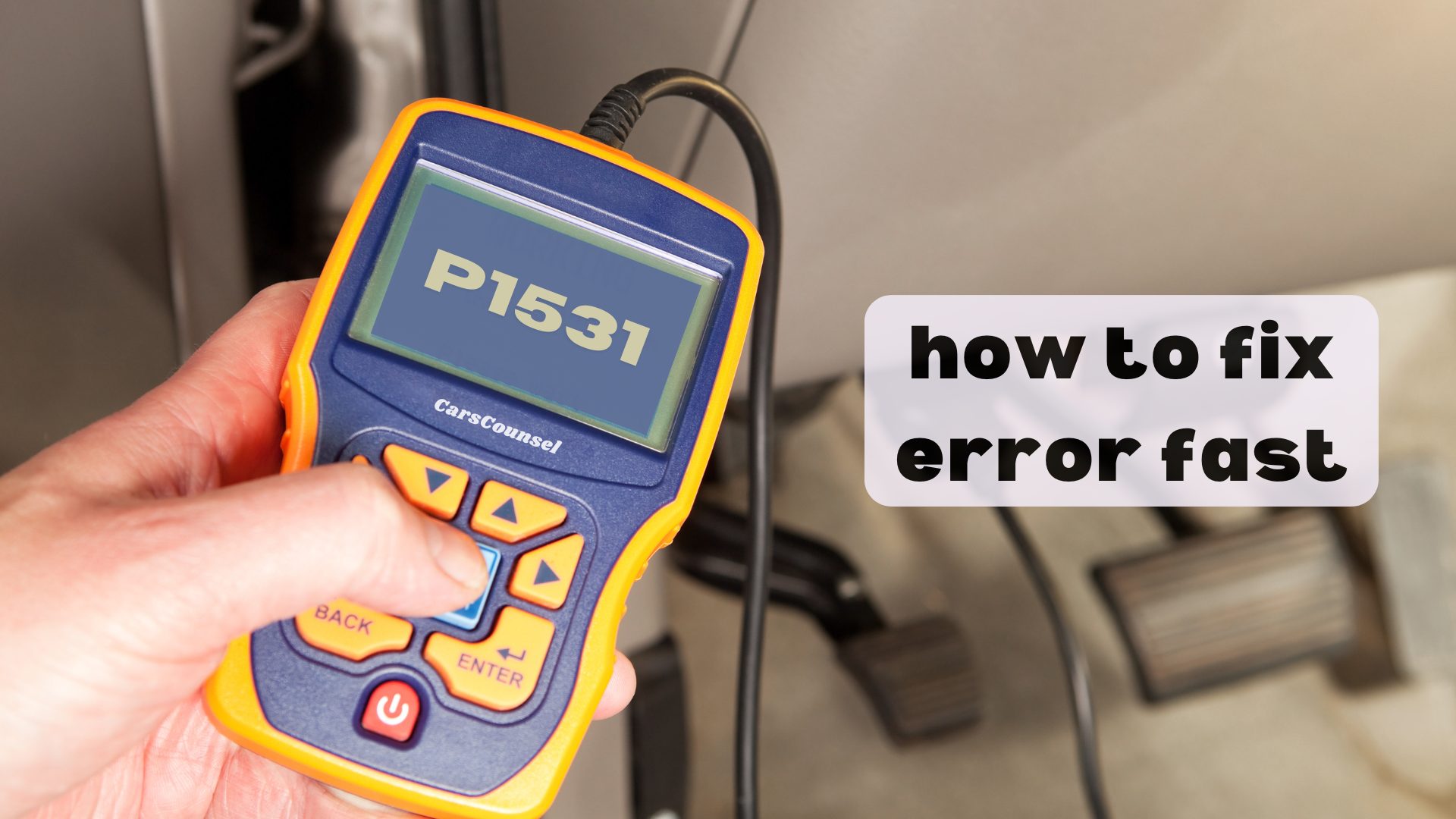If you’re experiencing inconsistent air conditioning performance, frequent compressor cycling, or an illuminated A/C warning light, you might be dealing with a P1531 code issue. This error code indicates a fault with the A/C low side temperature sensor, which is vital for maintaining peak cooling efficiency.
But what’s causing the sensor to malfunction? Is it a result of system maintenance neglect, low refrigerant levels, or perhaps an A/C system leak? You’ll need to dig deeper to determine the root cause of the problem and find a solution to get your air conditioning system running smoothly again.

Quick Navigation
Key Takeaways
- The P1531 code indicates a fault with the A/C low side temperature sensor, affecting the air conditioning system’s overall performance.
- A faulty sensor can cause poor cooling efficiency, inconsistent air temperature, and complete system failure.
- Causes of the P1531 code include system maintenance neglect, low refrigerant levels, and A/C system leaks or malfunctioning components.
- Diagnosing the issue involves verifying the code, inspecting the sensor and wiring, and checking refrigerant levels and A/C performance.
- Replacing the faulty sensor and performing a wiring inspection can resolve the P1531 code issue and ensure proper A/C system operation.
Code P1531 Description and Meaning
When your vehicle’s air conditioning system malfunctions, it can be a frustrating experience, especially during hot summer days.
The P1531 code indicates a fault with the A/C low side temperature sensor in your vehicle’s air conditioning system.
This sensor monitors the temperature of the refrigerant on the low-pressure side of the A/C system, playing a vital role in maintaining peak vehicle performance.
A faulty sensor can affect the overall performance of the A/C system, leading to poor cooling efficiency or complete failure.
As a result, you may notice inconsistent cooling performance, warm air from the A/C system, or the illumination of the A/C warning light on your dashboard.
Common Causes of the P1531 Code
Faults in the A/C low side temperature sensor can arise from a variety of sources, and identifying the root cause is crucial to effective repairs.
You’ll need to investigate sensor locations, such as the low-pressure side of the A/C system, to determine if the sensor itself is faulty or if there are wiring or electrical issues.
System maintenance neglect, like low refrigerant levels or A/C system leaks, can also trigger the P1531 code.
Additionally, other A/C system components may be malfunctioning, causing the sensor to fail.
Symptoms of a Faulty A/C Sensor
Several symptoms can indicate a faulty A/C low side temperature sensor.
You may experience inconsistent cooling performance from the A/C system, with the air blowing warm even when set to cool. The A/C compressor might cycle on and off frequently, or the system mightn’t work at all.
Additionally, you might notice the illumination of the A/C warning light on the dashboard.
These sensor malfunctions can lead to cooling issues, affecting the overall performance of your vehicle’s air conditioning system. If you’re experiencing any of these symptoms, it’s likely that your A/C low side temperature sensor is faulty and needs to be replaced.
Diagnosing the P1531 Code Issue
Now that you’ve identified the symptoms of a faulty A/C low side temperature sensor, it’s time to diagnose the P1531 code issue. To do this, you’ll need to use a scan tool to verify the code and confirm the sensor fault. Next, inspect the sensor and its wiring for any visible damage or corrosion.
| Step | Action | Purpose |
|---|---|---|
| 1 | Verify P1531 code | Confirm sensor fault |
| 2 | Inspect sensor and wiring | Identify visible damage or corrosion |
| 3 | Check refrigerant levels | Rule out low refrigerant as cause |
| 4 | Test A/C performance | Identify inconsistent cooling performance |
| 5 | Consult factory service manual | Gather more information on repair |
Replacing the A/C Low Side Sensor
One of the most critical steps in resolving the P1531 code issue is replacing the faulty A/C low side temperature sensor.
Before replacing the sensor, you should attempt sensor cleaning to verify it’s not just a buildup of debris causing the issue. However, if the sensor is damaged or corroded, replacement is the only option.
During the replacement process, perform a wiring inspection to identify any electrical issues that may be contributing to the fault. Make sure to handle the new sensor by the edges to prevent damage from skin oils.
Once the new sensor is installed, clear the diagnostic trouble codes and test the A/C system to guarantee it’s operating properly.
Repair Costs and Labor Estimates
The cost of repairing a faulty A/C low-side temperature sensor in your vehicle can vary depending on several factors, including the make and model of your vehicle, the labor rates of the auto repair shop, and the cost of replacement parts.
To get an accurate estimate, it’s essential to compare quotes from multiple shops.
A cost breakdown typically includes the cost of the sensor itself, which can range from $50 to $100, and labor costs, which can range from $100 to $200.
Be sure to ask about any additional fees or charges.
Troubleshooting A/C System Leaks
Inspect the A/C system’s components and connections to identify signs of refrigerant leaks, which can trigger the P1531 code.
You’ll need to employ leak detection methods, such as soap testing or ultraviolet (UV) dye testing, to pinpoint the source of the leak.
Refrigerant tracing is another effective method to identify leaks, as it involves injecting a fluorescent dye into the system and then using a UV lamp to detect the dye.
Be sure to inspect all connections, fittings, and seals, as these are common areas where leaks occur.
If you find a leak, you’ll need to repair or replace the faulty component before recharging the system with refrigerant.
Resetting the A/C System After Repair
After completing the repair of the P1531 code, it’s essential to reset the A/C system to guarantee it operates efficiently and effectively.
This process is vital to certify the system is functioning correctly and to prevent any future issues.
To perform an A/C system reset, follow these steps:
- Turn the ignition switch to the “on” position, but don’t start the engine.
- Turn the A/C switch to the “off” position.
- Wait for 10-15 seconds to allow the system to discharge.
- Turn the A/C switch back to the “on” position and start the engine.
This A/C refresh will reset the system and allow it to operate normally.
Preventing Future A/C System Faults
Proper maintenance is key to extending the lifespan of your vehicle’s air conditioning system and preventing future faults. Regular maintenance helps identify potential issues before they become major problems. Seasonal checks are essential to guarantee your A/C system is running efficiently throughout the year.
| Season | Check | Why |
|---|---|---|
| Spring | Refrigerant levels | Certify proper cooling performance |
| Summer | Air filter cleanliness | Prevent reduced airflow and increased pressure |
| Fall | System leaks | Identify and repair leaks before winter |
| Winter | System storage | Prevent corrosion and damage from moisture |
| Year-round | Electrical connections | Guarantee secure connections to prevent faults |
Additional Resources for Repair
When you’re faced with a P1531 code, having reliable resources at your disposal can make all the difference in getting your air conditioning system back up and running efficiently.
To help you through the repair process, consider the following resources:
- Factory Service Manuals: These provide detailed instructions and diagrams specific to your vehicle’s make and model.
- AC Forums: Online forums dedicated to air conditioning systems can offer valuable insights and experiences from others who’ve faced similar issues.
- DIY Guides: Step-by-step repair guides can walk you through the process of replacing the A/C low side temperature sensor.
- Auto Repair Websites: Websites like RepairPal or Autozone can offer repair estimates, diagrams, and tutorials to aid in your repair.
These resources can help you diagnose and fix the P1531 code, getting your A/C system back to peak performance.
More OBD-II Codes
Frequently Asked Questions
Can I Drive My Car With a P1531 Code?
You can drive your car with a P1531 code, but be aware of driving limitations and potential safety risks, such as overheating, which may cause further damage or even an accident, so it’s recommended to address the issue as soon as possible.
Will a Faulty A/C Sensor Affect My Car’s Fuel Efficiency?
You may wonder if a faulty A/C sensor will impact your car’s fuel efficiency; the answer is yes, as inaccurate sensor readings can lead to increased fuel consumption, since the A/C system will work harder to cool, affecting your overall fuel economy.
Can I Replace the A/C Low Side Temperature Sensor Myself?
You can replace the A/C low side temperature sensor yourself, but verify you locate it correctly, usually near the evaporator core or compressor, and have the necessary tools, such as a wrench and pliers, to complete the job safely and guarantee efficiently.
Will a P1531 Code Cause Damage to Other A/C System Components?
As you navigate the complexities of your A/C system, a sensor malfunction can be a ticking time bomb, potentially triggering a system failure that cascades into a costly repair nightmare; if left unchecked, it can indeed cause damage to other components.
Can a Faulty A/C Sensor Cause My Car’s Air Conditioning to Freeze?
You might experience cooling issues if a faulty A/C sensor affects sensor accuracy, leading to incorrect temperature readings, which can cause the system to malfunction and potentially freeze, resulting in reduced airflow and ice accumulation on the evaporator coils.
Conclusion
You’ve successfully diagnosed and repaired the P1531 code issue, restoring your air conditioning system to peak performance. Did you know that a faulty A/C system can increase your vehicle’s fuel consumption by up to 20%? By addressing this problem, you’re not only enjoying cooler temperatures but also saving money on gas. Guarantee your A/C system remains healthy by scheduling regular maintenance and inspections to prevent future faults, thereby maximizing its efficiency.

